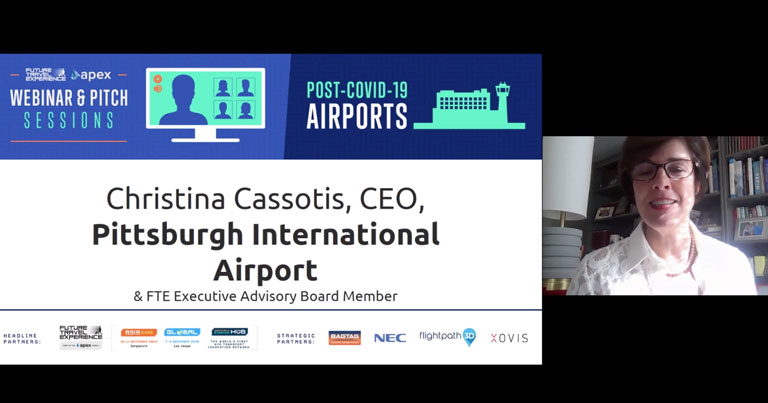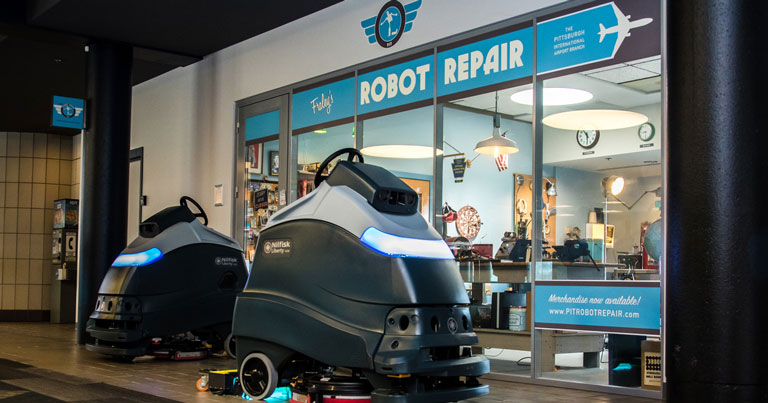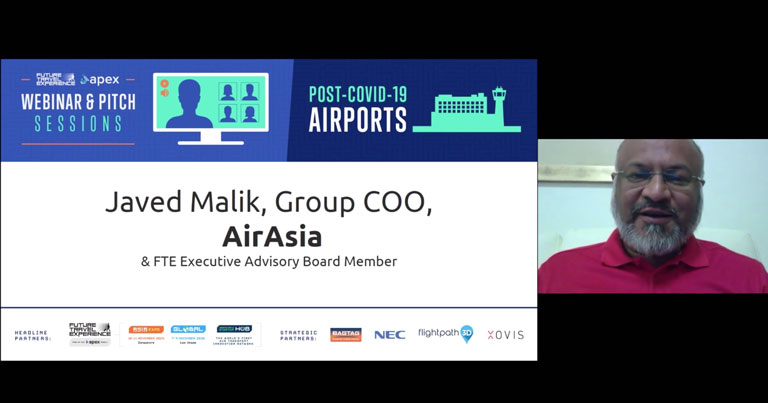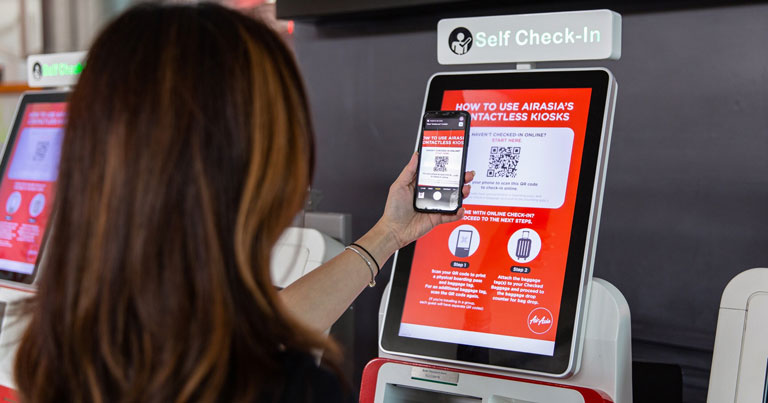The FTE APEX Post-COVID-19 Airports virtual event saw nearly 1,000 people from 100 countries tune in to watch industry leaders discuss their passenger experience plans and visions for the future. The live event provided a platform for airlines and airports to share their latest strategies to bring back confidence, while pitch sessions allowed suppliers to present their solutions and latest technologies for overcoming the COVID-19 crisis.
Among the highlights during the event was a panel discussion which focused on how collaboration and technology will be instrumental to building confidence in the industry.
Airports – a critical gateway for safer passenger experience

Kicking off the discussion was Dr. Joe Leader, CEO, APEX & IFSA, who provided some quick-fire recommendations on how the industry should evolve and adapt, especially in the airport environment, in response to COVID-19. He said: “APEX believes that airports will be the critical gateway for setting the tone for safer passenger travel in a COVID-19 world.”
In particular, Leader highlighted the importance of the airport security area. “Security remains the number one area for COVID-19 vigilance in my professional opinion. While a typical aircraft seat will be used by a handful of people each day, the touchpoints within security screening will be used by hundreds, and perhaps thousands of people each day.”
To drive this forward, APEX has launched a list of best practises for COVID-19, including advising all travellers and customer-facing airline employees to wear face coverings throughout their journey. Leader said: “This is an initiative we stated worldwide to airlines a couple of weeks ago and we have never seen such a fast response from airports and airlines around the world.
“As an industry we’ve always done a good job conveying security messages at the airport security checkpoints. So now, airport security and airports need to convey what they are doing to enhance sanitation and also stress the vigilance needed at airport security checkpoints.”
Outside of the security area, Leader urged airports to make the passenger experience as normal as possible with sanitation, spacing, social distancing queueing and seating, and signage to keep passengers informed and mindful.
Bringing back passenger confidence

Christina Cassotis, CEO, Pittsburgh International Airport, and a member of the FTE Executive Advisory Board, then addressed the key challenges Pittsburgh Airport has faced, and the steps it has implemented to tackle the COVID-19-related challenges.
“We’re doing a lot at Pittsburgh International and we have done in the past eight weeks. In fact, we have been monitoring this since late January and kicked in what we call IROPS or irregular operations as soon as the pandemic was announced.”

Cassotis took the opportunity to brief attendees on some of the latest initiatives being introduced at the airport, including face coverings, social distancing footprints, frictionless payment options, air filtration, and the adoption of autonomous floor scrubbers with UV technology in partnership with Carnegie Robotics.
“As each airline comes up with ideas for how they are going to manage, it is really going to be crucial that we come together as an industry to make sure that the passenger confidence starts at the kerb or when they park their car, and goes all the way until they depart the airport on the other end. And that really requires that airlines are working with us, the airports.”
Speaking from an airline perspective, Javed Malik, Group COO of AirAsia and an FTE Executive Advisory Board Member, also echoed Leader and Cassotis’ views on building confidence.
Malik said that AirAsia, which recently resumed its scheduled domestic flights, is leading the way in helping Asia bounce back after the crisis. “We need to bring the confidence back with the consumer, that’s our first and top priority. And building confidence is about demonstrating the procedures and processes, and that we care about our people and our guests and that their safety is paramount. The way we’re doing that is by bringing in technology. Collaboration at the scale that we’re now working at is phenomenal. Collaboration with technology, good safety standards, demonstrated visibly is the way forward for now.”
Safe, sanitised, seamless and contactless passenger experience

Creating a safe, sanitised, seamless and contactless experience has been widely discussed as being vitally important to getting the industry back on its feet and encouraging people to fly.
Addressing this Cassotis, said: “It’s a question of time and a question of implementation. Our challenge as an airport is that a lot of our concessionaires use different systems that need to be coordinated. We need to act really fast in figuring out what solution, or a suite of solutions, is going to work.”
Building on this, Malik again stressed the importance of using technology to create a touchless experience. “We have been on a digital journey for the last couple of years, but really coming to the forefront in the past couple of months in the investments we have made in the people, the teams, development and partnership has accelerated.”

Indeed, AirAsia has transitioned to contactless services across the whole ecosystem. The airline is rolling out several contactless procedures for essential travel including contactless payments at the airport, contactless kiosks, Passenger Reconciliation System (PRS) as well as enhanced features on its mobile app to help ensure a smooth and safe travel experience.
Malik also added that airline and airport apps are poised to become a major driver of allowing passengers to check-in, do visa checks, or upload medical certificate readings. “We can use OCR (Optical Character Recognition) technology and machine learning to verify whether the passenger has had a medical examination and whether we can then accept them to the check-in process. So, really looking at layering fast technology with the changes in the environment we see.”
However, there was a general agreement during the panel that communication will be critical to keeping passengers informed. Malik explained: “Observing behaviours, people still want to touch, so educating the public needs to be accelerated.”
Cassotis concurred: “Communication is critical at this time. When traffic starts to pick up again, I think we all have a responsibility to let passengers know that it is getting busier.
“We are looking at things like digital queuing to see what that technology looks like and how easily it can be adopted, because we do know that once we get back to half capacity those queues can be daunting.”
AirAsia has also taken a proactive approach to queue management and is currently boarding passengers in clusters of ten. “What we’re seeing now is that the public is compliant, and people are aware of the various measures the airports and airlines are taking and are being very supportive.”
“Cost is king, collaboration is queen”
Effective industry collaboration has never been more important to ensure the industry bounces back as quickly and effectively as possible. It has also become clear that working in siloes will prevent the industry from emerging faster and stronger from this pandemic.
Malik said: “For low-cost carriers, cost is king, but collaboration is queen. We see great relationships with regulators right now, coming forward and changing new policies that we were previously not even able to talk about. So, collaboration and understanding are very important parts.”
Cassotis added: “We are starting to collaborate more. This webinar is a great way of doing so. My biggest fear is that we will become imposed upon by governments in ways that don’t necessarily inspire confidence.
“We are working with the airlines that serve our airport and making sure we are talking to other airports around the world so that we can share information and that we can be part of a reaction to whatever governments and regulatory bodies tell us is going to be required. I think there needs to be a dialogue that needs to happen at an industry association level, such as IATA, ACI, US Travel and other organisations, so that people can understand what they are trying to do, and so that we have some input on whatever comes out of this as a set of standards that we will all have to adopt.”
Challenges
While it is clear that technology such as touchless kiosks, biometrics to verify passenger identity and mobile apps, will play an enormous part in helping the industry adapt, there will certainly be challenges that need to be addressed. During the webinar Rohit Talwar, CEO, Fast Future, highlighted three main areas:
- Funding – “The technology costs money and even with the best will of suppliers, ultimately airlines and airports will have to pay for it. There is an element that we have to do it to get passengers moving again, but there’s also an element of hope around the business case that over a three year period there would be enough travellers at the airport to warrant this, and that savings in all the other areas will pay for this.”
- Longevity – “There is an imperative to fully understand not only how these technology will help us deal with the current requirements of getting passengers through the airport while there is a pandemic, but also thinking longer-term about what does this enable, what kind of data we will be collecting with these platforms, what permissions we need from the passenger, so that we don’t end up putting things in a hurry and then later deciding it’s not what we need. It’s better to spend a little bit more time while passenger numbers are low to make sure we get right the longer-term thinking around the flexibility we want.”
- Consistency – “We need to take this opportunity to rethink what kind of experience we want to create and making sure that it feels consistent.”
100% traffic figures by 2025
The air transport industry is truly going through a unique period of change right now. Looking beyond the COVID-19 crisis, the closing panel shared insights into what the passenger experience might look like in 2025.
Turning the focus to airline connectivity, Leader said: “The good news is that there is a universal agreement that by 2025 we will be back to 100% traffic figures. Investments for environmental, technological advancements will remain on course, the one thing that may suffer will be the connectivity or routes, and the ease of getting from point A to B without having to connect. And I hope that is something we can return to sooner rather than later.”
Daniel Coleman, CEO, Future Travel Experience, predicts that a lot of the new approaches that the industry is bringing in now will be the new norm in 2025. He said: “The big change that will happen now, because of the big financial pressure that airlines and airports are experiencing, is that there will be a big push to drive efficiency.”
Talwar agreed that passenger figures will go back to 2019 figures in terms of volumes and revenues, however he foresees that 50% of airports and 50% or airlines that are around today could have disappeared or will be under new management. He said: “We’ll see a lot of new players coming in. We’ll see a transformed experience where some of the airlines will become a bit more like the hotel industry with the big brand pulled out of owning the assets. And we will start to see players who run the airline fleet and maybe even provide cabin crew. Some new business models will emerge with people who own the brand who are really focussed on the passenger experience completely and how they use the relationship with the passenger to deliver additional revenue streams.”
Talwar also expects that “invisible technology” such as touchless processing, artificial intelligence, robotics and blockchain will become increasingly common.
He said: “Personally, I think the way we will start to get more passengers flying again is by adopting offsite verification that proves that you have had an antibody test or a vaccination or a health certificate, so you don’t buy a ticket before having that. But also, we really need to focus on making a green experience and driving down the environmental footprint and as much as possible trying to take away the concept of “flight shaming”.”
Read more coverage of the FTE APEX Post-COVID-19 Airports webinar from FTE & APEX Media, including this article on how Dublin Airport is preparing for the new commercial and customer experience reality.






